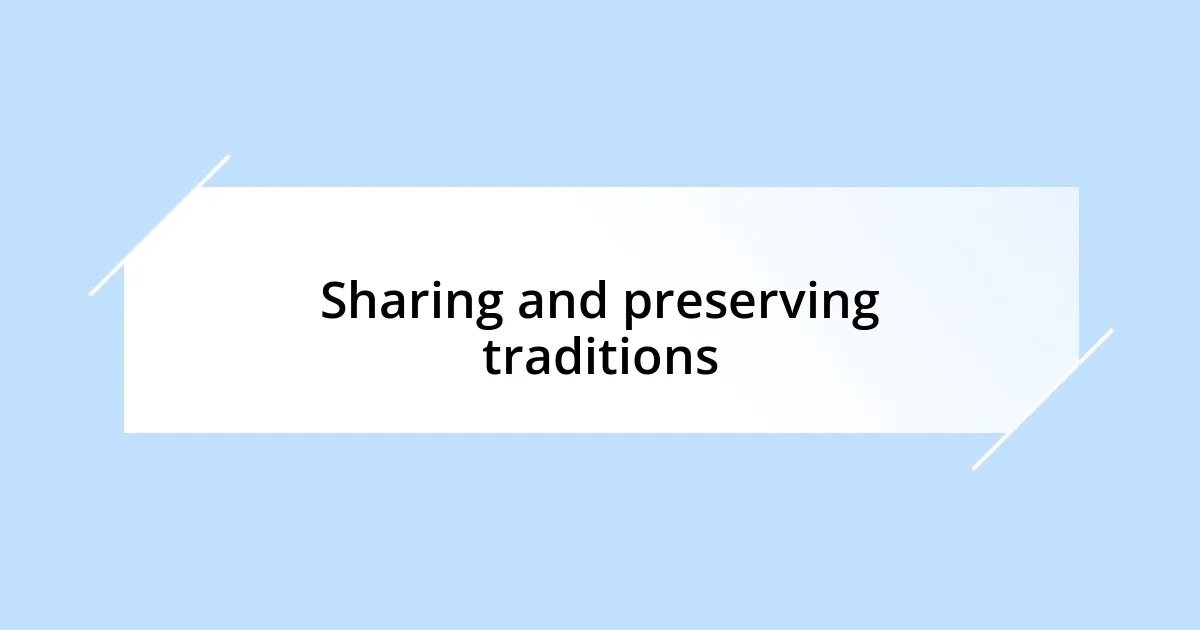Key takeaways:
- Cultural traditions are enriched through active engagement, such as participating in communal meals and local festivals, which help forge personal connections to heritage.
- Understanding cultural context is essential for appreciating the significance behind rituals and encourages empathy towards the traditions of others.
- Personal experiences, like hands-on workshops and storytelling circles, deepen one’s connection to traditions, revealing their emotional and historical importance.
- Sharing and preserving traditions through food, crafts, and storytelling fosters community bonds and ensures cultural legacies are passed to future generations.

Understanding cultural traditions
Cultural traditions are the living fabric of our communities, woven together by shared experiences and beliefs. I remember the first time I participated in a family gathering during a cultural festival; the colors, sounds, and stories unfolded like a rich tapestry. It made me wonder, how can something so seemingly simple encapsulate centuries of history and emotion?
When I think about understanding cultural traditions, I realize it’s not just about observing from a distance. It’s about actively engaging and connecting with those involved. For instance, during a communal meal, I learned the importance of each dish—each recipe carried stories from generations past. Have you ever tried to recreate a family recipe? It’s fascinating how cooking can bridge the past and the present, making me reflect on my roots while forging new memories.
Moreover, I’ve come to appreciate how traditions evolve over time. I once witnessed a modern twist on an ancient custom during a local festival—a perfect blend of old and new. Isn’t it intriguing how cultural traditions adapt yet retain their core essence? Understanding this dynamism adds depth to my appreciation of cultural customs, encouraging me to explore and celebrate diversity in an ever-changing world.

Importance of cultural context
Cultural context is crucial because it shapes the beliefs, values, and practices that define a community. I recall attending an event where the host explained the significance of each ritual before we participated. It was like opening a book of stories—stories that resonated deeply because they held cultural significance. Without understanding this context, we risk misinterpreting or overlooking the beauty and intent behind each action.
- It informs our responses to cultural expressions, making them richer and more meaningful.
- It helps us appreciate the nuances that influence social dynamics and communication.
- It fosters empathy, as we begin to see the world through the eyes of those whose traditions we’re exploring.
I think about how easily one can become a part of a vibrant cultural moment just by being mindful of its significance. One time, I asked a local elder about a particular festival’s history while we prepared for the festivities. Her eyes sparkled as she recounted personal connections to the rituals, revealing layers I hadn’t considered before. Engaging with cultural context not only enriched my experience but also deepened my respect for those traditions and the people who uphold them.

Researching local customs
Researching local customs is a journey that unveils the unique stories and practices woven into a community’s identity. I remember my first local market experience while traveling; the vibrant displays, fragrant spices, and animated conversations around me felt like stepping into a living history book. I realized that every item for sale represented a story embedded in the customs of that place, encompassing the lives of its people in a way that no textbook could replicate.
As I explored further, I discovered that reaching out to locals is incredibly rewarding. One time, I simply asked a vendor about the origins of their handmade crafts, and I was met with an enthusiastic recounting of family traditions passed down through generations. This not only enriched my understanding but also gave me a personal connection to the culture; it’s fascinating how a simple question can transform a tourist into a participant in a community’s legacy.
Additionally, the act of observing festivals and daily routines offers windows into local life that textbooks might miss. Attending a local celebration once gave me an insight into the community’s values; I spent hours watching families come together to honor their ancestors. The emotions in their faces, the shared laughter, and the solemn moments shared taught me more than any research paper ever could. Such experiences are the heart of understanding traditions — they awaken an appreciation that goes beyond mere observation.
| Research Method | Experience Gained |
|---|---|
| Market Visits | Understanding local products and their significance |
| Conversations with Locals | Gaining personal insights into customs and history |
| Participation in Festivals | Experiencing community values and emotional connections |

Engaging with community practices
Engaging with community practices transforms how we perceive and appreciate different traditions. I remember attending a traditional dance rehearsal, feeling the palpable energy of the dancers as they moved in unison. Their infectious enthusiasm made me ponder, how often do we miss out on such authentic experiences simply because we remain on the sidelines? Participating in these practices ignites a sense of belonging and connectedness that goes beyond mere observation.
I often find that sharing meals is an incredible way to engage with community culture. Once, at a potluck dinner, I was struck by the variety of dishes prepared, each telling a story of family heritage. As I savored each bite, I couldn’t help but ask my neighbors about their recipes. The conversations that flowed revealed personal histories intertwined with cultural significance, reminding me how food can act as a bridge, connecting us through shared flavors and experiences.
Attending community events, like local festivals or workshops, regularly enriches my understanding of traditions. I once joined a storytelling circle where participants shared tales passed down through generations. Listening to these stories felt like tapping into a wellspring of knowledge. This experience made me reflect on the power of narrative—how our stories mold our identities. Engaging with community practices in such ways isn’t just an activity; it’s a profound journey into the heart and soul of a culture.

Learning through personal experiences
Learning through personal experiences is incredibly impactful in grasping the richness of traditions. When I participated in a local pottery workshop, I felt a connection to the earth and its history. Shaping the clay with my hands was a tactile reminder that traditions are often anchored in the very materials of our environment. Have you ever felt how creating something with your own hands can link you to centuries of practice? Each piece of pottery I made carried the whispers of artisans who had come before me.
One vivid memory that stands out was when I joined a community drum circle. As I struck the drum and felt the vibrations resonate through my body, I was swept up in a collective rhythm that transcended language. It struck me—how often do we underestimate the deep, emotional bonds formed through shared experiences? In that moment, I realized that learning about traditions isn’t just about the “what”, but the “how” and “why.” The joy on everyone’s faces reflected a powerful sense of unity that words alone could never articulate.
Reflecting on these personal journeys, I can’t help but wonder—what if we approached every tradition with the same curiosity and openness? I recall a moment while volunteering at a local heritage site where I helped prepare for a traditional ceremony. The preparations involved rituals that had been preserved for generations. With each task, I understood the significance behind seemingly mundane actions. It made me appreciate how every little detail is infused with meaning. Experiences like these remind me that traditions live on not just through stories, but through the shared hearts and hands of those who carry them forward.

Reflecting on traditions personal impact
Reflecting on the personal impact of traditions can be quite profound. I remember the first time I observed a traditional wedding ceremony in my community. The vibrant colors, intricate rituals, and the palpable joy in the air left me in awe. It was a vivid reminder of how deeply traditions can shape our understanding of love and commitment. Have you ever felt that rush of emotion when witnessing a moment steeped in cultural significance? It’s as if each gesture tells a story that echoes through time.
There’s also something uniquely comforting about engaging with family traditions. I cherish Sunday afternoons spent with my grandparents, rolling out dough for homemade pasta. That simple act transformed into a beautiful ritual, rich with laughter and stories. Each pinch of flour seemed to carry stories from their past, linking generations together. Reflecting on these moments, I often find myself wondering—what traditions have been woven into the fabric of your own life? They have an uncanny way of grounding us, offering a sense of identity amidst the chaos of modern life.
When I think about the role of rituals in our lives, a specific cooking class I took comes to mind. It was focused on family recipes passed down through generations. As we chopped and sautéed, the instructor shared heartfelt anecdotes about her grandmother, and I felt a growing sense of connection. It struck me how food has the power to evoke memories and emotions that go beyond taste. Have you ever noticed how a familiar dish can transport you back in time? Those reflections reminded me that understanding traditions goes beyond mere observation; it’s about immersing ourselves in the experiences that shape who we are.

Sharing and preserving traditions
Sharing and preserving traditions is a beautiful endeavor that fosters connection within communities. I often think back to a family reunion where everyone brought their favorite dishes, each representing a story from our heritage. As we gathered around the table and shared our recipes, I could see how each dish sparked conversations, nostalgia, and laughter. Isn’t it fascinating how food can become a vessel for stories that tie us to our roots?
One experience that resonates deeply with me was participating in a cultural festival in my town. We had a storytelling booth where elders shared tales from their youth. Listening to their voices weave through time made me realize how vital oral traditions are for preserving cultural identity. Have you ever felt the magic of a story that transported you to another era? It taught me that sharing tales is not just about entertainment but a lifeline that connects generations.
Moreover, I’ve noticed that engaging in traditional crafts, like weaving or carving, is another powerful way to keep traditions alive. My grandmother taught me how to create simple crocheted items from old scraps of yarn. The patterns were simple, but each loop was filled with her teachings and wisdom. While crafting, I often wondered—how many hands had practiced this art before me? I realized that through these actions, we not only honor our heritage but also pass it down to future generations, ensuring that traditions thrive long after we are gone.














